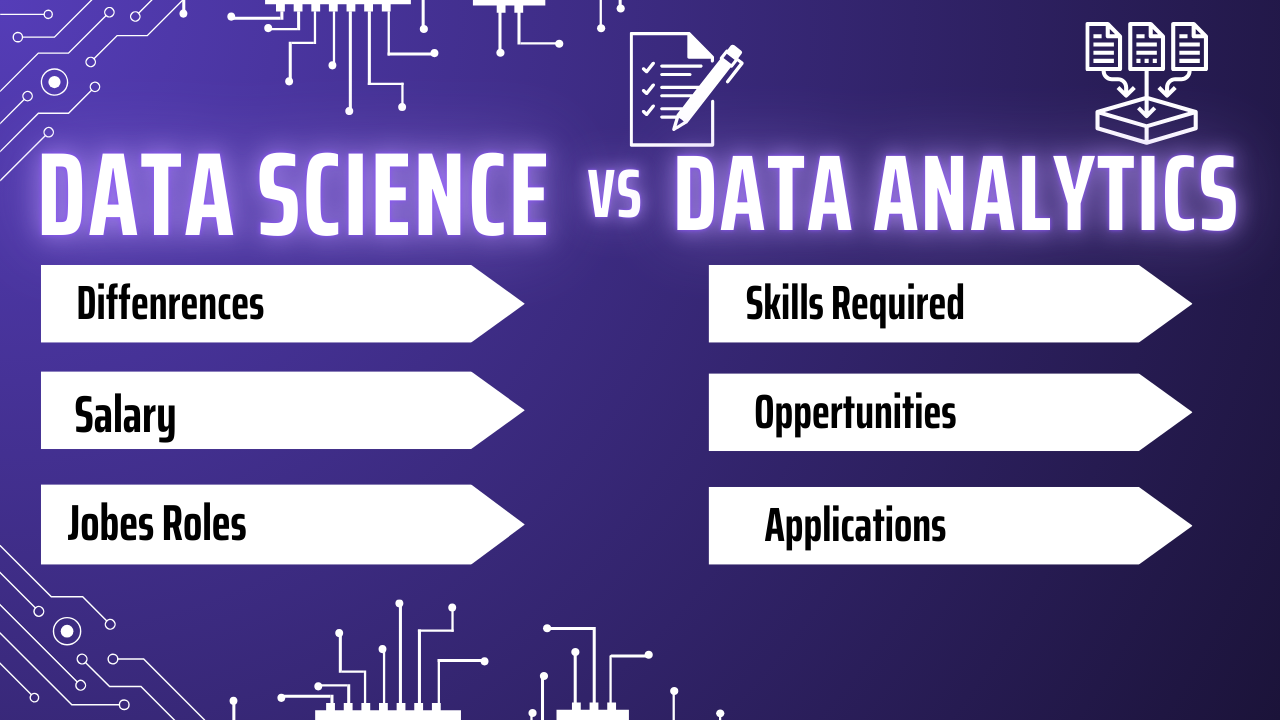Introduction
In today’s world, data powers everything from business strategies to everyday decisions. But when comparing data science vs data analytics, many wonder—what’s the difference? Both fields work with data, but each has a unique role: data science explores vast data to uncover patterns and make predictions, while data analytics focuses on specific insights to solve immediate business challenges.
As Clive Humby famously said, “Data is the new oil.” Just like oil, data must be refined to become valuable. In this guide, we’ll break down the differences in data science vs data analytics and explore how each field is transforming industries and creating exciting career paths.
1. Defining Data Science and Data Analytics
What is Data Science?
Data science combines numerous fields of work in statistics, machine learning and programming to analyze and interpret complex data sets. Its purpose is to discover trends and create predictive models, which are usually applied in unstructured data source such as social media feeds, audio, video,s etc. This area aids strategic decision making, empowering organizations to anticipate trends, track customer behavior and stimulate innovations.
Primary Responsibilities of a Data Scientist:
- To enable gathering and processing high volumes of both unstructured and semi-structure data
- Creating machine and predictive learning models
- Algorithm building using data to solve a complex business challenge
- Partnering with teams and applying analysis for strategic focus

What is Data Analytics?
In comparison, data analytics is more centered on analyzing past data to gain some insight and aid in the now. Data analysts, on the other hand, typically work with structured data (such as databases and spreadsheets) to filter and sort through this information in order to answer specific questions or find a way to optimize what they already have.
Primary Responsibilities of a Data Analyst:
- Collection, wrangling and preparation of data for analysis
- Based on trends and patterns to assist decision making
- A/B Testing for Performance Outcomes
- Dashboards and reports for visualizing data
2. Core Skills and Competencies
Though data science and data analytics are analytic in their nature, they have different sets of skills. Here is a list of fundamental skills that are essential for either domain:
Core Skills in Data Science
- Statistical and Mathematical Proficiency: Deep knowledge of statistics, probability, and machine learning
- Programming and Software Development: Python R or Scala experience, along with machine learning libraries like TensorFlow and Scikit-Learn.
- Managing Big Data: Knowledge of Hadoop, Spark and other big data platforms.
- Machine Learning Skills:Deep learning with Tensorflow,Models prediction
- Smarter Problem-Solving: Making high-level decisions based on deep data analysis
Core Skills in Data Analytics
- Data Processing and Cleaning: Strong ability to organize, cleanse, and structure data, particularly in Excel or SQL.
- Statistical Analysis: Proficiency in statistical tools, including SPSS and SAS, for interpreting data.
- Data Visualization: Proficiency in tools like Tableau, Power BI, and QlikView to create clear and actionable visual reports.
- Problem-Specific Analysis: Ability to answer specific business questions by analyzing trends and patterns.
- Communication and Reporting: Skill in clearly communicating findings to non-technical stakeholders.
3. Tools and Technologies
Different fields have different demands on the tools and technologies used by data scientists and data analysts. Take a glance at some of the tools often used in both fields:
Common Tools in Data Science
- Programming Languages: Python, R, and Scala are the preferred languages for data science due to their versatility and extensive libraries.
- Machine Learning Frameworks: TensorFlow, Keras, and PyTorch enable data scientists to create advanced machine learning models.
- Big Data Tools: Hadoop and Spark allow data scientists to handle large datasets efficiently.
- Visualization Tools: Matplotlib, Seaborn, and Plotly are commonly used for advanced data visualization.
Common Tools in Data Analytics
Data Processing SQL & Excel: Querying the data and store it in an organized manner to analyze is the primary feature of analytics.
Statistical Software: Examples include SAS and SPSS that are used in industries like finance and healthcare for statistical testing.
Visualization Tools: Data analysts use tools like Tableau, QlikView, and Power BI to create interactive reports for business applications.
Business Intelligence Platforms — Looker and Domo help to 분석 and visualize the data within a business context.

4. Applications and Use Cases
The applications of data science and data analytics can overlap, but they generally cater to different needs within an organization.
Data Science Use Cases
- Customer Behavior Prediction: Data science models predict customer purchase behavior and optimize marketing strategies.
- Healthcare Diagnostics: Machine learning algorithms analyze medical data to assist in diagnosing diseases.
- Financial Forecasting: Predictive models are developed to forecast stock trends, assess credit risks, and monitor financial health.
- Natural Language Processing: NLP models are used to analyze customer sentiment, often from social media or customer reviews.
Data Analytics Use Cases
- Customer Segmentation Analytics gives essential help in gathering customers for specific advertising campaigns.
- Optimization of Days: pinpoints process bottlenecks, recommending and implement taking action
- A/B Testing: Tests product or marketing strategies and comes in use to make decisions quickly.
- Sales analysis: Examines sales figures to determine which product lines are performing well and where there might be a gap in the market.
5. Career Paths and Opportunities
The demand for data science and data analytics professionals is global, with lucrative opportunities and diverse job roles.
Career Paths in Data Science
- Data Scientist: Work on complex models and the matrices behind them.
- Machine learning engineer: Focus on putting machine learning models into production.
- Data Engineer: Works on establishing data infrastructure, tuning data pipelines for the demands of data science.
- Research Scientist: Implements advanced analytic or experimental methodologies in disciplines such as genomics or AI research.
Career Paths in Data Analytics
- Data Analyst – Studies data in order to provide insight for short-term utilization.
- Business Intelligence Analyst: Converts data into meaningful information for business strategy.
- Operations Analyst: A data-centric role aimed at efficiency.
- Marketing Analyst: Analyzes data to shape marketing strategy and facilitate improved customer engagement.
Average Salary Insights
- United States: Data Scientist – $113,000; Data Analyst – $65,000
- United Kingdom: Data Scientist – £50,000; Data Analyst – £32,000
- India: Data Scientist – ₹1,000,000; Data Analyst – ₹600,000
- Germany: Data Scientist – €65,000; Data Analyst – €45,000
6. Key Differences Between Data Science and Data Analytics
As a result, being able to distinguish between the two can help you understand where each might be most appropriate given the kinds of problems and goals you have:
- Scope and Explorative/task: Data science is exploratory, its often adaptive to either discover trends or tend to building predictive models. Unlike data science, which is a more generic term for discovering insights from large amounts of raw data, either real-time or historical, data analytics is largely focused on performing specific tasks by using historical data to solve a particular problem already identified or optimizing the process.
- Data Types: Data science is employed on structured, semi-structured and unstructured data and data analytics is usually performed on structured data.
- Tools and Techniques: Machine learning and algorithm development are often seen in data science, while visualization and statistical analysis are more common in data analytics.
- Programming Requirements: Data science has an high need for mindset on programming and machine learning libraries, whereas data analytics focuses on SQL, Excel or visualization tools.
- Career Demand: Data scientists are in high demand for direct efforts in analyzing data and strategic insights, while data analysts play a critical role in helping organizations with operational support and decision-making.

Conclusion
Data science and data analytics both serve different importance in modern-day business, even more so for organizations dependent on data and analytics-driven decision making. If a company wants to predict trends or analyze some big data set with the use of AI and complex modeling, then they should prepare for data science; if it is sufficient for a company to report on and improve their processes based on facts however, they might want to stick with data analytics.
Either field is a strong option for professionals, as both are in high demand and you can work on meaningful projects. Once again, businesses need to ensure that data science and data analytics are aligned with the organizational objectives to realize maximum value – strategic forecasting or operational insights-based decisions.
As both fields are evolving continuously, the intersection of data science and data analytics will continue creating innovative solutions giving organizations a competitive edge globally.




